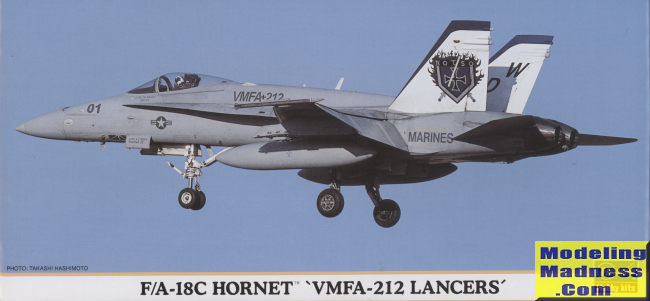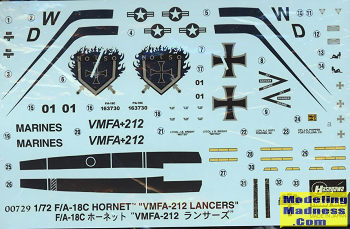
| KIT #: | 00729 |
| PRICE: | 1600 yen SRP when new |
| DECALS: | One Option |
| REVIEWER: | Scott Van Aken |
| NOTES: | 2004 Limited issue boxing |

| HISTORY |
When the Vietnam war was winding down, the US Navy was looking for a replacement aircraft for its F-8 and A-7 aircraft, though more for the A-7. A light strike fighter with the ability to hold its own in air to air combat was sought. the F-14 Tomcat was already slated for Fleet Defense and a replacement for the Phantom. Well, somewhere along the line, it was decided that what the Navy really wanted was the loser in the USAF's Light Fighter competition, the Northrop YF-17.
The YF-17 had several things going for it. One was a decent air to air capability and it had two engines. The Navy likes having an extra engine on its planes in case one quits while flying over water. Saves hassles, saves crews and saves money. However, the YF-17 was far too light for the Navy's needs. No way would that spindly USAF landing gear and airframe stand up to the pounding the plane would take on carrier decks. It also did not have enough range, and the list went on. A deal was struck with McDonnell/Douglas that they would develop and sell the Navy version, while Northrop would develop and sell a land based version. Northrop got screwed. No land based fighters were ever sold and they ended up just becoming a parts supplier to McD/Douglas.
Anyway, after years of trying to get the plane to meet specs, it was decided that for the good of the country and to keep overpaid aerospace workers able to pay off their motor homes, that the Navy would have to fudge on its requirements and accept a plane that was 90% as good as what they wanted. Eventually, as happens to almost every plane ever built, it was developed into an aircraft that was able to get the job done; just that it had to get closer to the job than was originally planned and it had to carry a lot of external fuel to do so. Now, nearly 30 years after entering fleet service, the original model is pretty well gone with but a few airframes flying with the Marines and with the Blue Angels.
| THE KIT |
 Hasegawa's
kit of the F-18 is by no means new. The original kit was a prototype with
raised panel lines and fairly good detailing. This kit had enough differences
with the production F-18 that a new one was tooled in the mid 1980s; this new
kit having engraved panel lines.
Hasegawa's
kit of the F-18 is by no means new. The original kit was a prototype with
raised panel lines and fairly good detailing. This kit had enough differences
with the production F-18 that a new one was tooled in the mid 1980s; this new
kit having engraved panel lines.
The kit is really quite well done and despite its growing age, holds up well when compared to more modern kits, though the engraving could be considered by some to be a bit soft. What this kit provides are the baseline sprues for the F-18A along with an additional sprue for the C model. The rather basic cockpit consists of a two piece seat, floor with side consoles and a control stick. The instruments are decals, which works well in this scale.
Hasegawa is a master of the 'multiple variants' and so all of their 1/72 F-18A/B/C/D kits have a set of four base sprues to which are added whatever is needed to make the specific variant. That means that the molds for these have gone through a lot of cycles. Despite that, they have held up well with only a bit of flash found. I also found two rather large depressions just forward of the LEREX exhaust that will have to filled in.
For things under wings you get three ferry
tanks and two sidewinders. Any bombs will have to come from the various
weapons sets. The two intake mounted sensors are included if you wish or you
can attach Sparrows. I've rarely seen F-18s with Sparrows in this position.
The boarding ladder may be posed down if you wish. Actually, there is no
'well' for it so that is a tad
inaccurate. The canopy and windscreen are
separate. No canopy actuator mechanism is included if you wish to pose your
canopy open. Though the kit cockpit is adequate, you may wish to substitute an aftermarket one for
that. 
Instructions are as good as you'd expect from a Hasegawa kit with Gunze paint references. Markings are provided for one aircraft as shown on the box photo from VMFA-212. Note that you are provided two outboard fin decals. One with the slime light and the other without it. The white fins will need to be painted, but the trim is provided on the decal sheet.
| CONCLUSIONS |
So, what you have is basically a mid 1980s kit that still holds up quite well. A bit of flash is all that tells its age and that is easily removed. What will draw folks to this kit is the paint scheme. As this is a limited reissue, you may need to hunt a bit of this particular boxing.
February 2019
Copyright ModelingMadness.com. All rights reserved.
If you would like your product reviewed fairly and quickly, please contact me or see other details in the Note to Contributors.